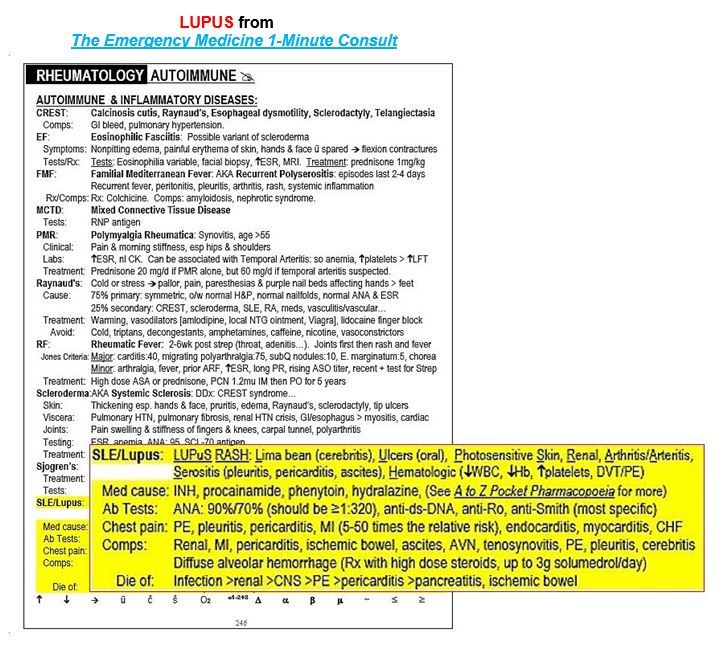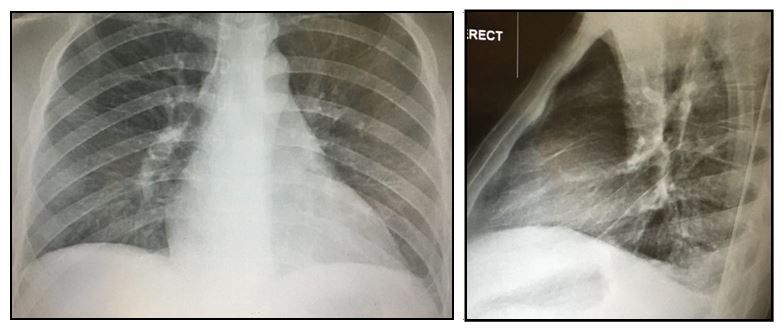- Clinical Technology
- Adult Immunization
- Hepatology
- Pediatric Immunization
- Screening
- Psychiatry
- Allergy
- Women's Health
- Cardiology
- Pediatrics
- Dermatology
- Endocrinology
- Pain Management
- Gastroenterology
- Infectious Disease
- Obesity Medicine
- Rheumatology
- Nephrology
- Neurology
- Pulmonology
Chest Pain, Fever, and Weight Loss
A 19-year-old previously healthy man presents with intermittent diarrhea, fever, and weight loss with pleuritic left-sided chest pain for 1 month. What does the chest x-ray show?
Figure. (Please click to enlarge)

Image. Chest x-ray (please click to enlarge)

Patient history
A 19-year-old previously healthy man is brought to the emergency department (ED) by his mother for 3-4 months of experiencing intermittent diarrhea and fevers up to 100.8°F with an associated 50-lb weight loss. The fevers are frequent, but not daily. He has also been having pleuritic left-sided chest pain for approximately 1 month. He denies cough, abdominal pain, vomiting, blood loss, or other complaints. He has been to other hospitals multiple times and no diagnosis was made but his symptoms continue to worsen.
Examination
Vital signs were normal except for a temperature of 100.3°F orally and a pulse of 121 beats/min. Physical exam was normal except for thin body habitus and tachycardia.
Initial concerns
- Pneumonia
- Pulmonary embolism
- Infectious diarrhea
- Cancer
- Syphilis, the great imitator
Testing
Laboratory studies: WBC low at 2.2x109/L, Hb low at 11.2 g/dL, albumin low at 2.9 g/dL, otherwise CBC and chemistries WNL.
Chest x-ray: See image above (please click to enlarge)
Questions
- What does the case image show?
- What should you do next?
âPlease click here for answers and diagnosis.
Answers
- What does the image show? A small left-sided pleural effusion (easier seen on the lateral view)
- What should you do next? Admit
Further testing: He was found to have ascites and underwent paracentesis with 1.2 L fluid removed. A malignancy and infection disease workup were both negative. CRP level was elevated at 40 mg/L, however, ESR was normal. The ANA titer was positive at 1:640, anti-dsDNA at 1:640, anti-Smith at 1:160, and anti-RNP at 1:200. He also developed new renal insufficiency (creatinine level peaked at 2.1 mg/dL) with microscopic hematuria.
Discharge diagnoses: Serositis (pleural effusions, ascites), leukopenia, anemia with thrombocytosis, and microscopic hematuria with new acute kidney injury with results of a renal biopsy showing lupus nephritis.
Conclusion: Following initiation of steroids, there was noticeable improvement in symptoms and lab work.
Please click here for discussion.
Discussion
Lupus can present in many ways and is rarely diagnosed de novo in the ED, though it may be suspected. This patient had a number of symptoms that were actually more concerning for an underlying chronic infection or even a malignancy than lupus. In this case the chest pain was due to serositis from lupus.
Systemic lupus may present with a variety of signs and symptoms. There is a useful mnemonic, “LUPUS RASH”, in the highlighted area of the Figure to the right (please click to enlarge) that may be helpful to remember most of them.
- L is for lima bean, which is for central nervous system involvement, which tends to be rare.
- U is for ulcers and is there twice; these are typically oral and are not that common.
- P and S are for photosensitive skin. The rash of lupus is most common on sun exposed areas.
- R is for renal involvement, which did occur in this case and is a major cause of morbidity.
- A is for arthritis, which is a common manifestation, and is also for arteritis, which is not common but can lead to stroke, myocardial infarction, cerebritis, ischemic bowel, and other complications.
- S is for serositis, which is not very common and typically affects the pleura, as in this case, the pericardium or the peritoneum.
- H is for hematologic as patients with lupus often have a chronic anemia and may also have leukopenia and immune suppression as well as venous thromboembolic disease.
The diagnosis of lupus is complex and beyond the scope of this brief review. Some of the antibody tests often ordered as part of the workup are listed in the highlighted area of the Figure above (please click to enlarge), which also has other useful details in summary format.
Additional information is availabe at: The Emergency Medicine 1-Minute Consult pocket book
